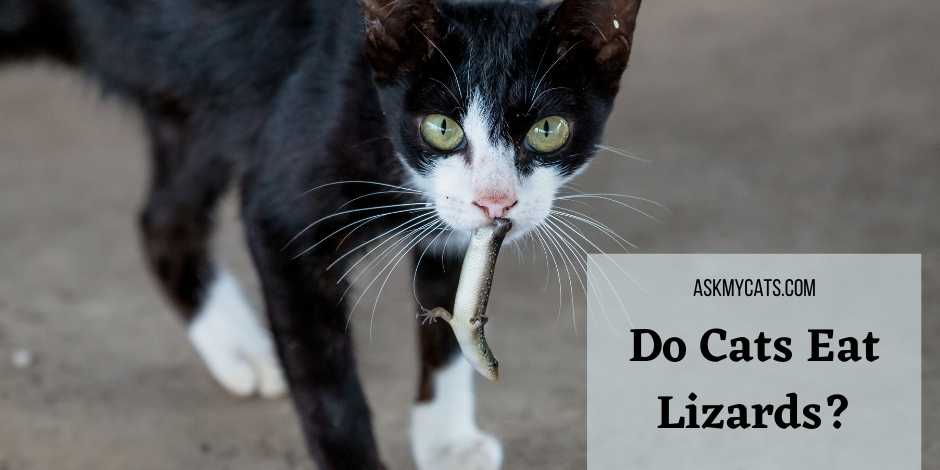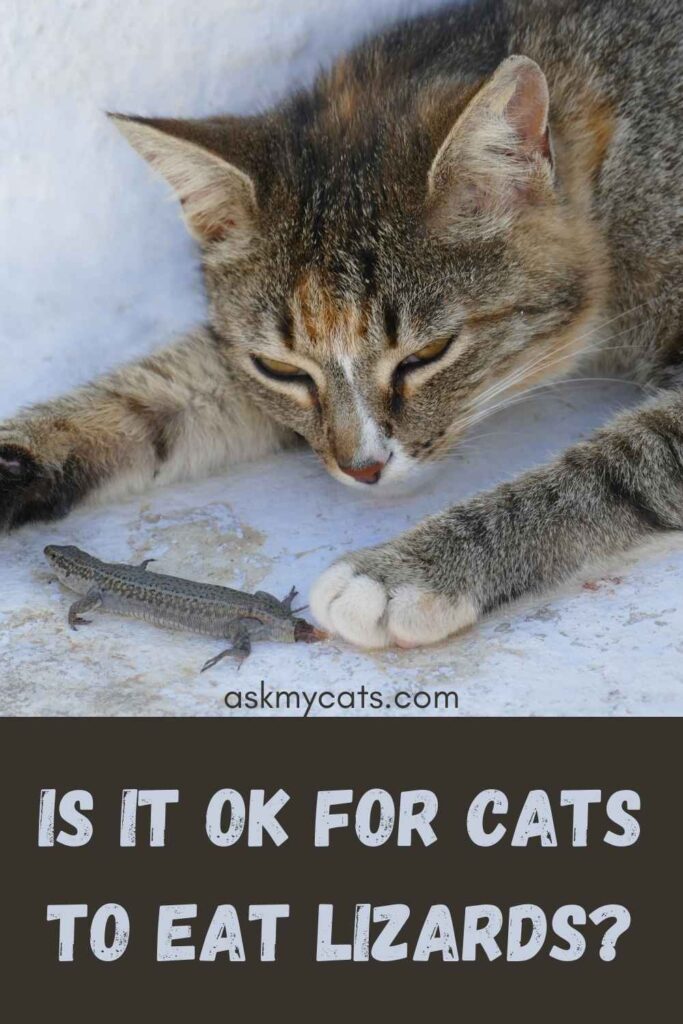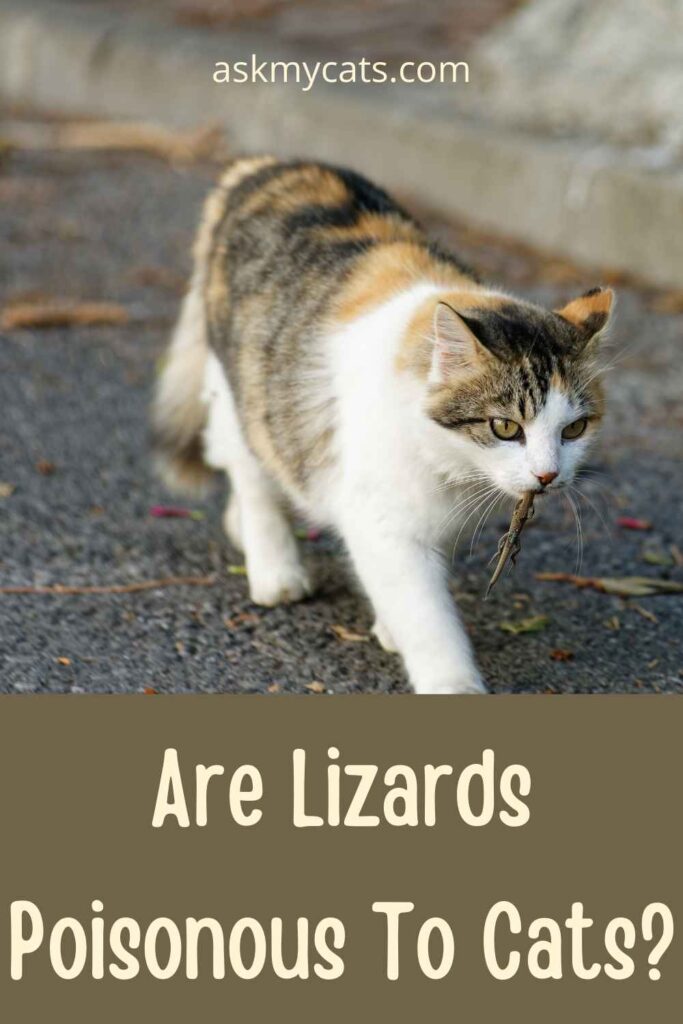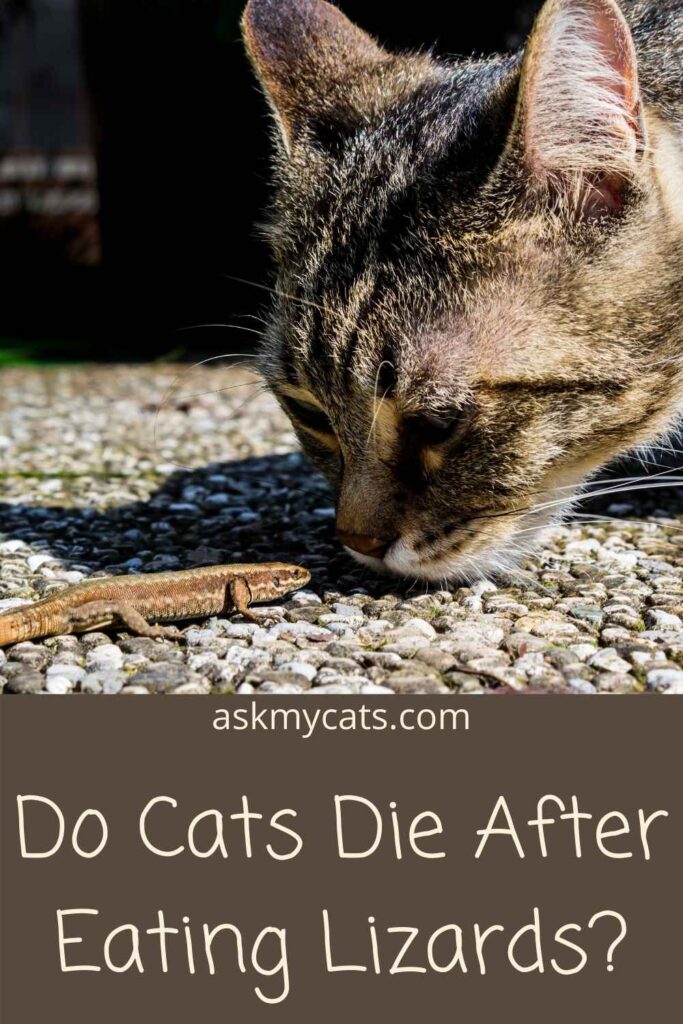Cats are animals that are fond of hunting animals that are smaller in size than them.
They love to chase smaller animals and kill them for their purposes and cats are known to enjoy the whole process.
Yes. Cats do eat lizards. Although lizards are typically harmless, eating one is not suggested since they might be toxic to cats.
Foaming at the mouth, vomiting, shakiness, and a lack of response are some of the symptoms of poisoning. North American lizards are simple to capture and feed for dogs and cats because of their tiny size.


Give Your Cat the Perfect Day
Get the Free Ebook!
Is It OK For Cats To Eat Lizards?
It is not good for a cat if it eats a poisonous lizard as it can damage the cat’s whole digestive system and kidneys.

Lizards can get into your house even if your cat is an indoor cat. Indoor cats will consider a lizard to be a delightful new toy to play with. The lizard will most likely be eaten by both indoor and outdoor cats.
A lizard’s existence is difficult, especially for the smaller species.
Lizards are struggling because there are so many predators out there looking for them to eat.They have a lot of adversaries to avoid compared to other prey.
Tiny lizards are nothing more than a source of fun and food for cats.
When there are a lot of lizards in a backyard or even indoors, they make great playmates and cat food.
Cats attempt and frequently succeed in killing everything from micro flies that I can barely see to flies, snakes, spiders, mice, rats, lizards, frogs, and even big rabbits.
Some cats consume their prey; I’ve witnessed cats devouring huge rodents and small bunnies. If a chunk is bitten off, a cat’s teeth will easily slice through the skin and bones of a huge rat and it will be eaten without chewing.
A cat’s environment is full of little meaty creatures that you kill and eat, or huge meaty creatures that you flee from unless they are your pet humans, in which case you pretend to be friendly so they feed you meat!
Cats are predators by nature. They like hunting and eating everything that moves, including lizards. It’s possible that a cat eating a lizard is safe, but it’s also possible that it’s deadly. Some lizards are toxic, while others may be difficult for your cat to digest.
Another possibility is if your cat ingests parasites that are present on or in the lizard. These parasites may wreak havoc on your pet’s digestive system.
The parasitic infection is known as liver fluke. They’re most common in Hawaii and the United States. It takes 8-12 weeks for this to develop, but it can move to the gallbladder and liver during that period. It leads to serious liver inflammation in the long run.
What Happens If My Cat Eats A Lizard?
Your cat may experience serious digestive problems after eating lizards since lizards contain toxic materials in their body.
Toxicity and infection are both hazards that lizards bring with them.
They also contain parasites known as liver flukes, which may be harmful to cats.
Nonetheless, cats eating lizards are typically safe, and there’s nothing to be concerned about.
Lizards that aren’t going to help them might make them sick. In most situations, the cats detect it and vomit it out right away.
If you’re concerned about this, it’s a good idea to keep your cat away from reptiles.
Are Lizards Poisonous To Cats?
It is not advised for a cat to eat lizards because lizards are potential toxic element carriers and also are the host for some deadly parasites.

Cats will sometimes merely play with the lizard until it becomes boring, but they will also catch and devour it.
If at all possible, remove the lizard or divert your cat’s attention away from the lizard to avoid your cat from eating it.
Photograph the rest of the lizard if your cat has eaten part of it to improve your chances of identifying the species.
Your cat will be OK in most situations, but there are certain hazards. The lizard might be venomous or contain parasites that are dangerous to humans.
Poisonous lizards may be found in many different species all over the world. Cats are not poisoned by several smaller lizard species.
If your cat has eaten a dangerous or unfamiliar reptile, keep an eye out for the following poisoning signs in cats:
- Unresponsiveness
- Tremors
- Drooling
- Extreme thirst
- The mouth is foaming
- Vomiting
- A shift in bathroom usage
- Diarrhea
- Unpredictable movement
- Pale gums
- Appetite loss
If you observe any of these signs, you should take your cat to the doctor right soon. Poison/toxicity must be addressed as soon as possible.
Even if the lizard your cat ate was not toxic, there are a few health issues to consider.
One of the primary worries is if the lizard carried parasites. If your cat consumes a parasite-infested reptile, it may experience severe stomach problems. The main problem is liver fluke parasites.
These are most often seen in the United States and infect a cat’s liver, gallbladder, and bile ducts.
Liver fluke causes severe liver inflammation over time (it takes 8-12 weeks for liver fluke to develop).
Among the symptoms of Liver Fluke are:
- Lethargy
- Fever to Lose Weight
- Distention of the Abdomen
- Vomiting
- Diarrhea and Jaundice
Salmonella is another possible, although less common, a problem that your cat may encounter after eating a lizard.
This bacterium can induce vomiting, diarrhea, tiredness, fast heart rate, loss of appetite, and fever.
While most cats are immune to salmonella, it is critical to take them to the doctor as soon as you see any symptoms.
Do Cats Die After Eating Lizards?
Sadly, ingesting a lizard can result in a cat’s death. Between the lizard’s potential toxicity and the parasites that may be present inside the lizard, eating a lizard is not guaranteed to be safe for a cat.

Blue-tailed lizards and skinks may be seen in your area no matter where you reside. They’re toxic to predators, and if your cat bites or consumes one, the chemicals in their skin will most likely cause a response in her.
You may observe that she is vomiting, drooling, stumbling, and has a mild temperature.
She could also become angry and refuse to eat. Similar symptoms, such as diarrhea and even paralysis, are caused by newts and salamanders.
Rinse your kitty’s mouth thoroughly with water to ensure that all poisons have been removed, and take her to the doctor right away.
If your cat spends time outside, she may come into contact with poisonous or deadly reptiles. More likely, she’ll come across innocuous ones that seem like tasty snacks or entertaining toys.
Unfortunately, cats are among the most dangerous predators of lizards, and numerous studies have linked outdoor pets to fast lizard population reductions.
Keeping your cat inside will not only keep her safe, but it may also save the life of the lovely animal lounging on your porch.
The Nile monitor is another lizard that may be dangerous to your cat, even though it is non-venomous. These lizards, which can grow up to 7 feet long, are offered as exotic pets, but they frequently escape or are released into the wild.
Because Nile monitors have begun to breed in South Florida, it’s extremely vital to keep a lookout for them. When they are left to their own devices, they feed on small animals, including cats.
Poison and toxicity, if not treated promptly, can lead to death. After 12 weeks, liver flukes can potentially cause mortality. Flukes in the liver can cause liver failure.
Take your cat to the doctor right away if you find your cat has eaten a lizard and is showing signs of sickness. It’s fair to believe they’re ok if they act normal and don’t exhibit any indications of illness.
Because cats frequently prey on lizards, your cat is a far greater menace to them than they are to her. However, some lizards are poisonous or otherwise dangerous. You can help keep your kitten safe if you know what they look like and where they dwell.
How Do I Stop My Cat From Eating Lizards?
The best way to stop your cat from eating lizards is to restrict their movements so that they do not get hold of any lizards to eat.
Some of the methods listed below can help you keep your pet cat from eating lizards.
Keep your pet indoors. This will deter cats from eating or preying on lizards in the wild. While indoors, you may also keep a careful eye on your cat’s activities.
Keep your pet lizards in a secure enclosure. To avoid getting eaten, it’s critical to keep your pet lizard away from cats. Make an effort to keep your lizard in a cage that cats won’t be able to get into.
Protect your premises. Seal any gaps or gaps in the walls where lizards may hide or pass through to keep your house or compound lizard-free.
To prevent lizards from climbing over from the outside or neighborhood, the top of the wall should be flat.
Teach your cat to choose the choice to depart. Your cat can be taught not to eat lizards. Professionals can achieve this by teaching the cats to leave any lizards they come across on their route. This approach is both time-consuming and costly.
Why Does My Cat Bring Me Live Lizards?
Cats bring live lizards to their owners as a token of gift and also to showcase their hunting abilities.
Cats were created to hunt. Even although domesticated cats are aware that they do not require their food to exist, they cannot resist the impulse to hunt and chase.
Some cats that catch prey may bring the dead animals—or, even worse, sometimes still alive animals—to their owners to show off their prized catch for later eating, as a teaching tool, or as a gift.
Cats with a well-balanced diet are most often looking for entertainment. This provides them with cerebral stimulation as well as physical activity. If your cat brings you a ‘gift,’ such as a live lizard, you know how much they adore you!
Cats behave differently than dogs or guinea pigs when it comes to showing affection. They have a reputation for being self-sufficient and frigid, although this isn’t always the case. Cats have a special way of expressing their affection for animals.
Cats exhibit affection by guarding you and expressing their gratitude by providing you with food. The cat feels obligated to help out around the house in some manner. They want to express their gratitude for your protection and want to repay the favor.
They could also believe you’re a lousy hunter. They wish to assist you and show you how to search in this instance.
Whatever the source, it is still a gesture of compassion and love. You should feel privileged that your cat adores you as much as you adore them! They merely present it differently.
This capturing of prey action has nothing to do with hunger. Instead, the “prey” captured by indoor cats is frequently toy mice, balls, and rubbish that they believe they are “hunting.” Even though they are inedible, these objects can be given to you as presents.
Frequently Asked Questions
Can cats smell lizards?
Reptiles, like any other living thing, have a distinct odor that is linked with them. Cats can smell the lizards and quickly recognize them.
Do cats kill lizards?
Even though cats are natural hunters, killing and eating lizards can be harmful to your cat, so keep an eye on him when he’s out hunting. Please see your veterinarian as soon as possible if your cat exhibits any of the symptoms I’ve mentioned. It may be the difference between life and death for your cat.
Are lizards scared of cats?
Cats are natural adversaries of lizards, and a lizard will seldom enter the home if there is a cat there. I have a cat, but my ceilings are extremely high. Geckos can walk upside down on the ceiling, which means they’ll be safe from a cat up there.
Final Words
For the sake of the cat’s health and that of the lizards, cats should avoid eating them. Lizards may be poisonous to cats and can also spread illnesses.
Liver fluke and salmonella are two frequent illnesses spread by lizards.
Most lizards are not venomous, but some, such as the Gila monitor and the Komodo dragon, have venom that paralyzes its victim when injected.
Use some of the methods listed above to keep your pet cat from eating lizards.
